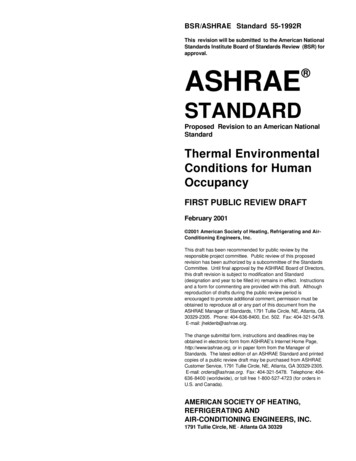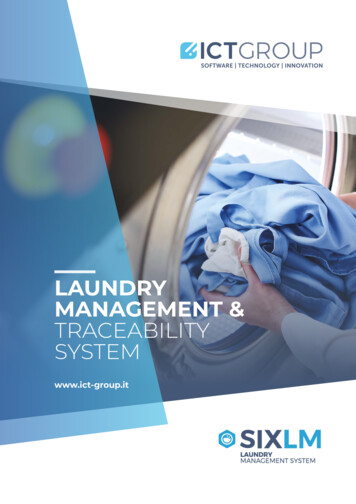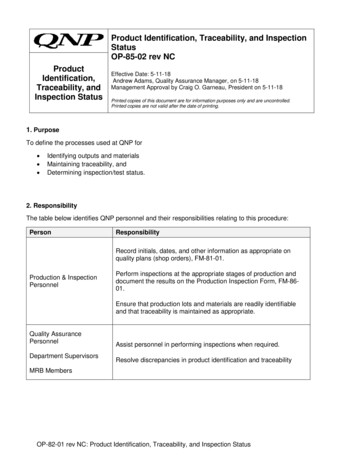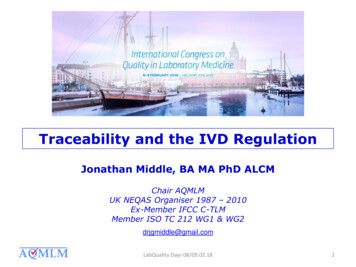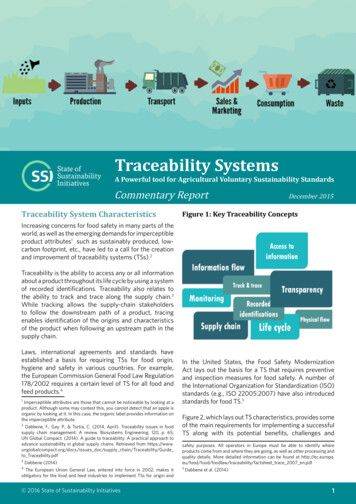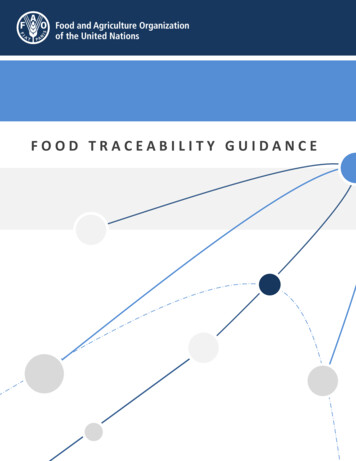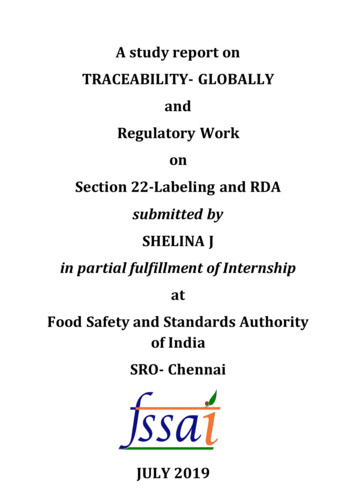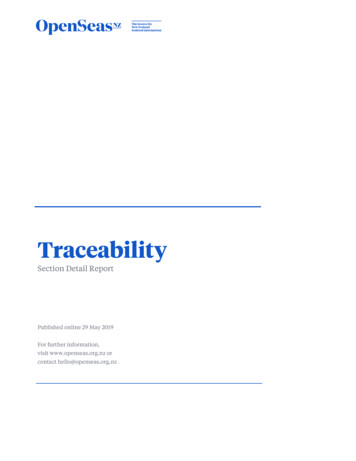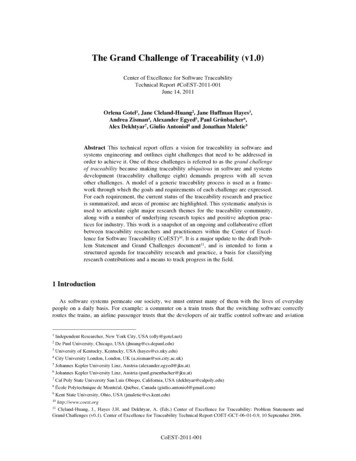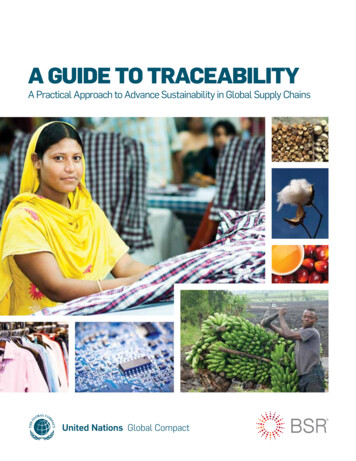
Transcription
A Guide to TraceabilityA Practical Approach to Advance Sustainability in Global Supply Chains
About the United Nations Global CompactLaunched in 2000, the United Nations Global Compact is both a policy platform and apractical framework for companies that are committed to sustainability and responsiblebusiness practices. As a multi-stakeholder leadership initiative, it seeks to align businessoperations and strategies with ten universally accepted principles in the areas of human rights, labour, environment and anti-corruption, and to catalyze actions in support ofbroader UN goals. With 8,000 corporate signatories in 145 countries, it is the world’s largestvoluntary corporate sustainability initiative.www.unglobalcompact.orgAbout BSRBSR works with its global network of more than 250 member companies to build a justand sustainable world. From its offices in Asia, Europe, and North and South America, BSRdevelops sustainable business strategies and solutions through consulting, research, andcross-sector collaboration. Visit www.bsr.org for more information about BSR’s more than20 years of leadership in sustainability.DisclaimerThis publication is intended strictly for learning purposes. The inclusion of company ororganization names and/or examples does not constitute an endorsement of the individualcompanies by the United Nations Global Compact Office or BSR. The material in this publication may be quoted and used provided there is proper attribution. The views expressedin this publication are those of its authors and do not reflect those of BSR members or UNGlobal Compact participants. The UN Global Compact encourages the dissemination of thecontent for education purposes.About this GuideThe findings in this report are based on the following: interviews with company, traceabilityscheme and Non-Governmental Organization representatives; a survey of UN Global Compact Supply Chain Advisory Group members; and a desktop review of literature, case studies and analysis of traceability information. Extensive consultation was also conducted toensure the usefulness and content of this guide. The UN Global Compact and BSR expresstheir deep appreciation to all those who have contributed to this project.BSR developed this report with the support of the UN Global Compact. Members of the UNGlobal Compact Advisory Group on Supply Chain Sustainability provided significant editorialinput. The Office of the High Commissioner for Human Rights provided input on how to alignthe guide with the Guiding Principles on Business and Human Rights endorsed by the UNHuman Rights Council. Any errors that remain are those of the authors.BSR team: Tara Norton, Julia Beier, Lauren ShieldsUN Global Compact team: Anita Househam, Elena Bombis, Daniella LiewDesigners: Nilou Safavieh, Tannaz Fassihi Copyright 2014United Nations Global Compact OfficeTwo United Nations Plaza, New York, NY 10017, USAEmail: globalcompact@un.org
Table of ContentsIntroduction 4Part 1: Global Alignment on Traceability 61. Definition: Traceability 2. The Evolution of Traceability 3. The Impact of Traceability 667Part 2: Traceability in Practice 1. Traceability Models 2. The Landscape of Global CollaborativeTraceability-Focused Organizations 3. Best Practice in Traceability Part 3: Practical Guide for Companiesto Pursue Traceability 1. Drivers and Benefits 2. The Practicalities of Traceability:Implementation in Seven Steps 3. Alternatives to Traceability 4. Keys to Successful Implementation:Helpful Advice from Peers 101015182020242629Conclusion and Outlook for the Future 31Annex: Traceability by Commodity:Gaps and opportunities for collaboration 32End Note 44
4 A Guide to TraceabilityIntroductionThe UN Global Compact and BSR are pleasedto issue this guide to help companies andstakeholders understand and advance supplychain traceability, which is the process of identifying and tracking a product or component’spath from raw material to finished good.This guide represents more than a year ofwork in preparation, research and interviews.PurposeThe purpose of this guide is to provide anoverview of the importance of traceability forsustainability purposes, outline the global opportunities and challenges it represents andsummarize practical steps for implementingtraceability programmes within companies.Research for this guide revealed that traceability is a tremendously impactful tool foradvancing sustainability objectives, but it stillhas a long way to go before it is an integralpart of sustainable supply chain managementand is used widely by companies. At present,only a very small percentage of commoditiesare traceable on sustainability attributes.Traceability must be a collaborative effort. This guide aims to show companies andstakeholders the benefits of working togetherto implement a common approach to traceability across commodities.Summary of the GuideThis guide is divided into three sections: In Part 1, the guide defines traceabilityand explores its history, benefits and challenges, including an overview of currentcollaborative schemes on traceability. In Part 2, the guide demonstrates a modelfor best practice in traceability, and provides an overview of the different modelsof traceability and the global initiativesoperating in the arena. In Part 3, the guide provides guidance tocompanies around the world, large andsmall, on how to effectively engage intraceability.Target AudienceThis guide is primarily aimed at supply chain,procurement, sourcing and sustainability professionals who seek to improve the sustainability of their companies’ supply chains, andAbout Supply Chain Sustainability& the United Nations Global CompactThe UN Global Compact encourages participants to develop more sustainable supplychain practices, including by engaging with their suppliers around the UN Global Compact Ten Principles. To assist companies in improving the sustainability of their sourcingpolicies and practices, the UN Global Compact promotes material initiatives and goodbusiness practices that explore critical issues and has developed guidance on how tointegrate the Ten Principles into supply chain management systems.To guide its work on supply chain sustainability, the UN Global Compact has establishedan Advisory Group of Global Compact participants and stakeholders. The role of theAdvisory Group is to provide input to the overall strategy and work of the UN Global Compact on the issue of supply chain sustainability, and to ensure that the guidance materialdeveloped is robust and addresses the needs of businesses.The Advisory Group has established task forces to develop various tools and resources tohelp businesses integrate the UN Global Compact principles into supply chain relationships. This guidance is the result of the work of the Traceability Task Force.
A Guide to Traceability 5who are considering traceability. Individualsalready engaged in traceability in some wayand those who are new to the topic will gainvalue from this guide.Our aim is to provide lessons that areapplicable across industries, geographies, inreference to a vast range of commodities, andto large multinationals as well as small businesses. The real-life case studies and interviews with practitioners provide companieswith concrete examples and clear ways toimplement traceability standards.For organizations involved in traceability,such as traceability schemes and Non-Governmental Organizations (NGOs), this guideprovides a comprehensive overview of thetraceability landscape and the benefits thatthese organizations are providing to ensurethe sustainability of products. This guide alsocalls out key areas where traceability schemesneed global support, and points companiesin the direction of offering the right kind ofguidance.Research MethodologyThe findings and recommendations in thisguide are based on the following: a review ofpublically available information, literatureand case studies about supply chain traceability; an analysis of existing traceability schemes;and interviews with individuals at companies,traceability schemes and NGOs who havesignificant experience in traceability.Interviews were conducted with 12 companies (multinationals), 4 companies (suppliers),9 traceability schemes, and 4 relevant NGOs,using a standard interview template thatwas then coded and analyzed for trends. UNGlobal Compact and BSR wish to acknowledge and thank all participants.
6 A Guide to TraceabilityPart 1Global Alignment on Traceability1. Definition of TraceabilityThis guide will use a hybrid of the widelyaccepted definition of traceability from theInternational Organization for Standardization (ISO), with the added key component of asustainability focus:Traceability: The ability to identify and tracethe history, distribution, location and applicationof products, parts and materials, to ensure thereliability of sustainability claims, in the areas ofhuman rights, labour (including health and safety),the environment and anti-corruption.Background on the definitionAlthough traceability schemes have slightlydifferent definitions for traceability, they allreference a process by which a product movesfrom its original raw material extraction andproduction phase to the final customer. Theoriginal ISO definition of traceability is “theability to identify and trace the history, distribution, location, and application of products,parts, and materials”.1In order to ensure traceability along thesupply chain, a system is needed that “recordsand follows the trail as products, parts,and materials come from suppliers and areprocessed and ultimately distributed as endproducts”.2 Such traceability systems provideinformation on the components of products,parts, and materials as well as information ontransformations throughout the value chain.At the end, traceability ensures the accuracyof this information, such as product quality,safety and labeling.In the context of sustainability, traceabilityis a tool to assure and verify sustainabilityclaims associated with commodities andproducts, ensuring good practice and respectfor people and the environment all along thesupply chain.For example, schemes ensuring thatminerals are not sourced from conditions ofarmed conflict (known as “conflict minerals”)aim to address the human rights abuses inconflict areas and avoid purchasing materials that can directly or indirectly financeand increase the intensity of those conflicts.Programmes that certify the use of productsthat are grown in sustainable cultivations,whether they relate to food (e.g. cocoa, nutsor coffee) or to other commodities (e.g. cottonor wood), can have numerous effects on theenvironment, from the reduction of carbonfootprint to the prevention of deforestation.Definition of Traceability SchemesWhen we refer to “traceability schemes”throughout this document, we are referring toorganizations whose purpose is ensuring thesustainability of raw materials, for whom traceability plays some role. These organizations aregenerally labeling or certification organizations,and industry or commodity roundtables. It isimportant to note that these organizations areat different levels of advancement in terms ofimplementing traceability.2. The Evolution of TraceabilityThe History of TraceabilityTraceability dates back to as early as the1930s when some European countries wantedto prove the origin of high-quality food suchas French champagne.3Over the past two decades, food safety related issues and various food scandals in theagribusiness sector, such as mad cow diseaseor the Asian bird influenza, have highlightedthe importance of traceability. The need fortraceability has also extended to other industries, due to issues of product quality, safetyand security.In 2005, the European Commission implemented several directives and regulationson food safety, which increased the focuson traceability in agricultural commodities.These food law guidelines address “traceability of food and feed products, responsibilityof operators, withdrawal of unsafe food orfeed from the market and notification to thecompetent Authorities”.4
A Guide to Traceability 7Beyond food safety, consumers, NGOs, governments, suppliers and buyers increasinglydemand more information about the originsof their products and materials and the conditions under which they were produced andtransported along the value chain. With theincrease in demand for organic, fair trade andenvironmentally friendly products and materials, well-functioning traceability systemsand new technologies have been developed tomeet stakeholder needs.Traceability forSustainability ClaimsToday, traceability is a useful tool for companies to advance sustainability and proveclaims and attributes of sustainable products. Companies undertake traceabilityprogrammes to improve their supply chainmanagement in various ways.Some companies who have a strongunderstanding of their supply chain andknow their main suppliers well have instituted their own traceability programmes andschemes for certain commodities, often whenthose commodities are a critical resource fortheir products.Companies and stakeholders in industrieswith complex supply chains, such as theagricultural and retail industry, have cometogether to build global multi-stakeholder initiatives in order to trace commodities collaboratively. These global traceability schemes,such as the Forest Stewardship Council (FSC),the Marine Stewardship Council (MSC) orUTZ Certified, have engaged with stakeholders along the entire value chain in order todevelop credible and robust chain of custodystandards and certification for products fromthe raw material to the final use phase.Traceability is not a substitute for duediligence or the broader scope of the corporate responsibility to respect human rights5.Readers of this guide should be mindfulthat traceability schemes may only uncoverone set of risks and not all potential adverseimpacts, depending on the specific nature ofthe traceability sche
Traceability: The ability to identify and trace the history, distribution, location and application of products, parts and materials, to ensure the reliability of sustainability claims, in the areas of human rights, labour (including health and safety), the environment and anti-corruption. Backgroundonthedefinition.File Size: 1MBPage Count: 45

